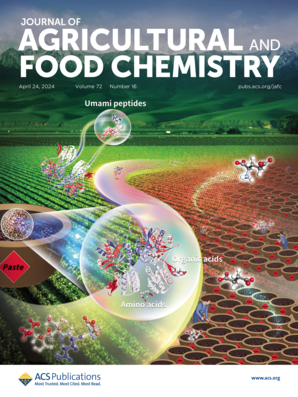Green Tea Epigallocatechin-3-gallate Ameliorates Lipid Accumulation and Obesity-Associated Metabolic Syndrome via Regulating Autophagy and Lipolysis in Preadipocytes and Adipose Tissue
IF 5.7
1区 农林科学
Q1 AGRICULTURE, MULTIDISCIPLINARY
引用次数: 0
Abstract
Previous studies have shown that epigallocatechin-3-gallate (EGCG), the most abundant catechin in green tea, demonstrates promising antiobesity effects. While autophagy mediates obesity via preadipocyte differentiation and lipogenesis, EGCG’s potential autophagy-dependent antiobesity mechanism remains unclear. We used 3T3-L1 cells and high-fat-diet (HFD)-fed mice to examine how EGCG inhibits adipogenesis and lipogenesis via autophagy. EGCG (50 or 100 mg/kg) significantly attenuated HFD-induced weight gain, fat accumulation, hyperlipidemia, and glucose intolerance in mice. It also enhanced autophagy and lipolysis in white adipose tissue (WAT). EGCG profoundly inhibited terminal preadipocyte differentiation and lipid droplet formation in 3T3-L1 cells accompanied by reduced PPARγ, C/EBPα, and FASN expressions. Mechanistically, EGCG inhibited autophagy during the early stage of preadipocyte differentiation, as evidenced by increased autophagosome accumulation and impaired autophagic flux. The antiadipogenic effect of EGCG was further aggravated by the autophagy inhibitor chloroquine. Meanwhile, EGCG increased p38 and AMPK/ACC phosphorylation while inhibiting JNK phosphorylation in 3T3-L1 cells at an early stage of adipogenesis. Interestingly, EGCG reduced the expression of lipolytic enzymes HSL and ATGL, and it decreased glycerol contents in differentiated 3T3-L1 cells. These findings provide novel insights into the mechanism of using green tea EGCG in functional foods to combat obesity by targeting autophagy and lipolysis.

绿茶表没食子儿茶素-3-没食子酸酯通过调节脂肪前细胞和脂肪组织的自噬和脂肪分解改善脂质积累和肥胖相关代谢综合征
之前的研究表明,绿茶中含量最多的儿茶素——表没食子儿茶素-3-没食子酸酯(EGCG)具有很好的抗肥胖作用。虽然自噬通过前脂肪细胞分化和脂肪生成介导肥胖,但EGCG依赖自噬的潜在抗肥胖机制尚不清楚。我们使用3T3-L1细胞和高脂饮食(HFD)喂养的小鼠来研究EGCG如何通过自噬抑制脂肪生成和脂肪生成。EGCG(50或100 mg/kg)可显著减轻hfd诱导的小鼠体重增加、脂肪积累、高脂血症和葡萄糖耐受不良。它还能促进白色脂肪组织(WAT)的自噬和脂肪分解。EGCG显著抑制3T3-L1细胞终末前脂肪细胞分化和脂滴形成,同时PPARγ、C/EBPα和FASN表达降低。从机制上讲,EGCG在前脂肪细胞分化的早期阶段抑制自噬,这可以通过自噬体积累增加和自噬通量受损来证明。自噬抑制剂氯喹可进一步增强EGCG的抗脂肪作用。同时,EGCG增加了3T3-L1细胞脂肪形成早期p38和AMPK/ACC的磷酸化,抑制了JNK的磷酸化。有趣的是,EGCG降低了分化3T3-L1细胞中脂溶酶HSL和ATGL的表达,并降低了甘油含量。这些发现为在功能性食品中使用绿茶EGCG通过靶向自噬和脂肪分解来对抗肥胖的机制提供了新的见解。
本文章由计算机程序翻译,如有差异,请以英文原文为准。
求助全文
约1分钟内获得全文
求助全文
来源期刊
CiteScore
9.90
自引率
8.20%
发文量
1375
审稿时长
2.3 months
期刊介绍:
The Journal of Agricultural and Food Chemistry publishes high-quality, cutting edge original research representing complete studies and research advances dealing with the chemistry and biochemistry of agriculture and food. The Journal also encourages papers with chemistry and/or biochemistry as a major component combined with biological/sensory/nutritional/toxicological evaluation related to agriculture and/or food.

 求助内容:
求助内容: 应助结果提醒方式:
应助结果提醒方式:


